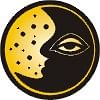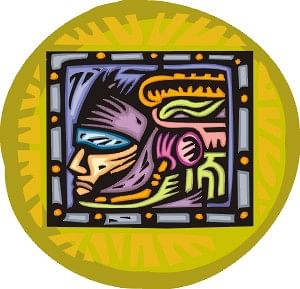DARKNESS
...SILENCE
By
Rudmila Rahman
 “Blindfold
yourself for one entire day to see how it feels like to be blind.
Then write an essay about your experience". This was an assignment
my class 8 English teacher once gave the class. After an entire day
(well…almost and entire day!) of having a bandanna over my eyes felt
like an eternity of darkness and was positively relieved the very
moment I took it off. This experience sprang from the back of my mind
and came to my attention a few days ago when our school's (Chittagong
Grammar School) community service organization, which I am a part
of, took a trip to the Government School for the Blind and the Deaf,
Muradpur, Chittagong.
“Blindfold
yourself for one entire day to see how it feels like to be blind.
Then write an essay about your experience". This was an assignment
my class 8 English teacher once gave the class. After an entire day
(well…almost and entire day!) of having a bandanna over my eyes felt
like an eternity of darkness and was positively relieved the very
moment I took it off. This experience sprang from the back of my mind
and came to my attention a few days ago when our school's (Chittagong
Grammar School) community service organization, which I am a part
of, took a trip to the Government School for the Blind and the Deaf,
Muradpur, Chittagong.
The handicapped population of Bangladesh is very under-represented
and often misunderstood. Misconceptions arise out of our lack of understanding
about their illnesses, stemming from general wariness and the lack
of mass publicity. Most of us were not even aware that such a school
in Chittagong existed; let alone 5 all over the country, catering
to the needs of all sorts of handicapped children…mentally and physically.
The school is completely funded by the government,
and has the stereotypical qualities of most government funded organisations
and schools (which I would rather not go into the details of). Situated
in quite a dingy area of the city, the crumbling building holds approximately
80 students, 50 of who are blind and 30 of whom are deaf. However
the atmosphere inside was a completely juxtaposed to the exterior;
it was a absolutely dissimilar world.
The
sound of a melodious voice led us up to the second floor where we
entered a classroom full of song. While a girl played the harmonium
and sang, a boy was on the tablas and another was shaking a tambourine.
They were all blind. Another boy, whose mysterious looks interested
us all sat on one of the classroom benches and was diligently listening
to the music, and nodding his head to his own rhythm, with occasional
bursts of furtive smiles. He looked straight at everybody individually
though his glossy eyes, as if he could see within us. Entering the
classroom, I felt as if I was trespassing in the children's' serene
world. All eyes were on us, but none of the eyes could see, although
they did 'perceive'.
More students came filing in with whom we talked and
took pictures. Soon, more songs sung by the senior students enchanted
us all. A small deaf boy danced for us, to music he could not hear,
but strangely, followed the rhythm to. It was as if the vibrations
of the harmonium and those of his body were one and the same.
The teachers of the school informed us about their
activities and the prospects for blind and deaf children in Bangladesh.
We were introduced to the Braille alphabet, a language system consisting
of a sequence 6 raised dots on paper (3 each, in 2 columns, forming
a symmetric rectangle) each pattern representing different letter
in English, Bengali and Arabic (or any other language for that matter),
using which the blind can pass their fingers over to read. The deaf,
as we all know, primarily use sign language but are also taught to
lip read and communicate through gestures.
 Many
of the school's blind students are keen on pursuing further education.
Although the school is only up to class 8,this school, in conjunction
with other normal government schools help support those who wish to
study further. They can even give their S.S.C exams via Braille books
and tape recording supplements. Exams are completed with the help
of a student who can read out the questions to them while they dictate
back the answers. Many of their students have also commenced tertiary
education, one of them, from a family where all four of the daughters
are blind, is currently studying Law at Chittagong University.
Many
of the school's blind students are keen on pursuing further education.
Although the school is only up to class 8,this school, in conjunction
with other normal government schools help support those who wish to
study further. They can even give their S.S.C exams via Braille books
and tape recording supplements. Exams are completed with the help
of a student who can read out the questions to them while they dictate
back the answers. Many of their students have also commenced tertiary
education, one of them, from a family where all four of the daughters
are blind, is currently studying Law at Chittagong University.
Unfortunately, the educational facilities for the
deaf are not so adaptable. Higher education is just about unavailable
for them. They cannot hear therefore they cannot talk and because
they cannot talk they find it difficult to remember the language that
they study. But vocational and technical work is always an option
open to them. Careers in art and painting, cloth work, photography
and handicrafts are bright prospects for the deaf.
Other than formal education, the curriculum for the
deaf and the blind include ADM or Activities for Daily Mobility and
ADL, Activities for Daily Living. This, as the name suggests ensures
that they can get though the day by themselves. The exercises that
are taught and practised focus on and try to cultivate the other senses
that the blind and deaf possess.
They must keep their senses active through exercises
on touch, taste smell and motion. When on the road, a blind person
can ascertain the position and type of a vehicle that is coming towards
them and at what speeds it is moving by listening to the sound it
makes. When a blind person shakes your hand you may find that they
are feeling it, because like fingerprints, every hand has a certain
shape and texture. They can later identify you though your grip. Height
assertion is also possible by calculating the level and angle from
which your voice if reaching their ears. A person's weight can also
be estimated by the thud of their footsteps. I'm sure some of you
have wondered how blind people seem to be able to figure out I someone
is in the room. Well… sensing the disruption in the wind flow pattern
helps them accomplish this. Amazing isn't it! Their other functioning
senses are so coordinated and acute that it makes up for their loss.
It is this sixth sense that enables them to endure a world, which
has been constructed to provide for the needs of the bodily and psychologically
impeccable.
Taking the example of the blind girl with the beautiful
voice, once you help her with a tune on the harmonium, she can pick
it up very quickly and play it without mistakes. One of their teachers
explained that because we have our eyes, our minds are distracted
easily; they go where are eyes direct them. The blind thus have the
advantage of being able to concentrate hard on one single activity,
being able to carry it out even without the help of their eyes.
Another interesting thought is how there is such an
eclectic mix of deaf and blind children in the school, but they cannot
mix with each other due to a lack of means to communicate. The blind
cannot see the sign language by which the deaf talk no more than the
deaf can hear the words that the blind are capable of saying. Yet,
they make the most of the time they spend together.
The teacher training to teach theses children composes
of a 3 yr course, the B.S.Ed, where among the teachers not only learn
Braille and sign language and special care of the handicapped, but
participate in exercises like being blindfolded, spun around a few
times and left in the middle of Asad Gate in Dhaka and asked to get
back to their classroom alone. They do this to put themselves in the
shoes of the handicapped, so that this 'feel' of how it is like to
be impaired will facilitate teaching.
The teachers' commitment to their cause is extremely
appreciable.. Not many people would forfeit a traditional educational
and enrol in a B.S.Ed course even though it would culminate in a qualification
to help the visually and hearing impaired children of the country.
Despite their poor allowances and virtually nil recognition, teachers
have dedicated their careers to ensuring that these children get the
best possible education the government can give them and strive to
make sure that they get an equal chance to excel in life.
However, as many government organizations, this sector
of social services and welfare lacks necessary funds and initiatives.
It is the individual or minimally collective effort of the teachers,
which actually keeps theses schools running. Being a federal organization,
they cannot accept external funds or donations, thus remaining in
limbo, trying to make ends meet to provide satisfactory education.
This experience really made me think. Pity and compassion
for the handicapped are ever existent, but we know so little about
them that we unconsciously isolate them, treating as if they are immature
(even adults) and not capable of fending for themselves. They want
nothing to do with our sympathy, but as I observed, would like encouragement
and attention. These children have a hidden power, such a strong will.
The blind let you see them in a way in which you don't need eyes and
they deaf let you hear them in way in which sounds will not be enough
to express their inner desires.
Be it in their mysterious smiles or knowing looks,
they are not letting a physical deformity impede their mental growth
and development. From now on, when I think that my life is unfair,
and I am not getting hat I deserve, or even if the noise pollution
in the roads during peak traffic hours in getting on my nerves, I
will remember these children and I will remember how they jump high
across the thick hurdles in their paths and mange to land safely on
the other side.
Close your eyes…you are the same and someone who is
blind, shut out all incoming sounds … you are the same as someone
who is deaf. At the end of it all, we are very much similar; we are
all human and have much to learn from each other.
